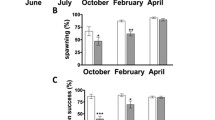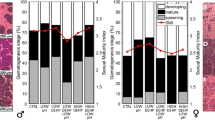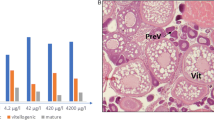Abstract
Genitors of the Pacific oyster Crassostrea gigas were submitted during gametogenesis to a short pulse exposure to the herbicide diuron at a realistic environmental concentration. Histological analysis showed no effect of diuron on gametogenesis course, sex ratio and reproductive effort. A non-significant increase in testosterone and progesterone levels was observed in genitors exposed to the herbicide. At cell level, diuron exposure was shown to modulate the phagocytic activity of circulating hemocytes. The results of a transcriptional analysis showed that diuron affected the expression of genes belonging to functions known to play a major role during oyster gametogenesis such as gene transcription regulation, DNA replication and repair, DNA methylation and cytokinesis. Taking into account the results we previously obtained on the same genitors, this study showed a negative effect of diuron on oyster reproduction by inducing both structural and functional modifications of the DNA.






Similar content being viewed by others
References
Abass K, Reponen P, Turpeinen M, Jalonen J, Pelkonen O (2007) Characterization of diuron N-demethylation by mammalian hepatic microsomes and cDNA-expressed human cytochrome P450 enzymes. Drug Metab Dispos 35:1634–1641
Akcha F, Spagnol C, Rouxel J (2012) Genotoxicity of diuron and glyphosate in oyster spermatozoa and embryos. Aquat Toxicol 106–107:104–113
Anderson RS (1985) Metabolism of a model environmental carcinogen by bivalve molluscs. Mar Environ Res 17:137–140
Armiliato N, Ammar D, Nezzi L, Straliotto M, Muller YM, Nazari EM (2014) Changes in ultrastructure and expression of steroidogenic factor-1 in ovaries of zebrafish Danio rerio exposed to glyphosate. J Toxicol Environ Health A 77:405–414
Auffret M, Duchemin M, Rousseau S, Boutet I, Tanguy A, Moraga D, Marhic A (2004) Monitoring of immunotoxic responses in oysters reared in areas contaminated by the “Erika” oil spill. Aquat Living Res 17:297–302
Barranger A, Heude-Berthelin C, Rouxel J, Adeline B, Benabdelmouna A, Burgeot T, Akcha F (submitted) Parental exposure to the herbicide diuron resulted in oxidative DNA damage in germinal cells of the Pacific oyster, Crassostrea gigas. Comp Biochem Physiol
Barranger A, Akcha F, Rouxel J, Brizard R, Maurouard E, Pallud M, Menard D, Tapie N, Budzinski H, Burgeot T, Benabdelmouna A (2014) Study of genetic damage in the Japanese oyster induced by an environmentally-relevant exposure to diuron: evidence of vertical transmission of DNA damage. Aquat Toxicol 146:93–104
Barranger A, Benabdelmouna A, Dégremont L, Burgeot T, Akcha F (2015) Parental exposure to environmental concentrations of diuron leads to aneuploidy in embryos of the Pacific oyster, as evidenced by fluorescent in situ hybridization. Aquat Toxicol 159:36–43
Berthelin C, Kellner K, Mathieu M (2000) Histological characterization and glucose incorporation into glycogen of the Pacific oyster Crassostrea gigas storage cells. Mar Biotechnol 2:136–145
Bouilly K, Bonnard M, Gagnaire B, Renault T, Lapègue S (2007) Impact of diuron on aneuploidy and hemocyte parameters in Pacific oyster Crassostrea gigas. Arch Environ Contam Toxicol 52:58–63
Buisson S, Bouchart V, Guerlet E, Malas JP, Costil K (2008) Level of contamination and impact of pesticides in cupped oyster, Crassostrea gigas, reared in a shellfish production area in Normandy (France). J Environ Sci Health Part B 43:655–664
Burgeot T, Gagnaire B, Renault T, Haure J, Moraga D, David E, Boutet I, Sauriau PG, Malet N, Bouchet V, Le Roux A, Lapègue S, Bouilly K, Le Moullac G, Arzul G., Knoery J., Quiniou F, Barcher C, Soletchnick P (2008) Oyster summer morality risks associated with environmental stress. In: Samain, J.F., McCom-Bie, H. (Eds.) Summer Mortality of Pacific Oyster Crassostrea Gigas. The Morest Project. Éd. Ifremer/Quæ pp 107–151
Bustamante P, Luna-Acosta A, Clemens S, Cassi R, Thomas-Guyon H, Warnau M (2012) Bioaccumulation and metabolisation of (14)C-pyrene by the Pacific oyster Crassostrea gigas exposed via seawater. Chemosphere 87:938–944
Caquet T, Roucaute M, Mazzella N, Delmas F, Madigou C, Farcy E, Burgeot T, Allenou JP, Gabellec R (2013) Risk assessment of herbicides and booster biocides along estuarine continuums in the Bay of Vilaine area (Brittany France). Environ Sci Pollut Res 20:651–666
Clode SA (2006) Assessment of in vivo assays for endocrine disruption. Best Pract Res Clin Endocrinol Metab 20:35–43
Dheilly N, Lelong C, Huvet A, Kellner K, Dubos MP, Rivière G, Boudry P, Favrel P (2012) Gametogenesis in the Pacific oyster Crassostrea gigas. A microarrays-based analysis identifies sex and stage specific genes. PLoS ONE 7:e36353
Dimastrogiovanni G, Fernandes D, Bonastre M, Porte C (2015) Progesterone is actively metabolized to 5α-pregnane-3,20-dione and 3β-hydroxy-5α-pregnan-20-one by the marine mussel Mytilus galloprovincialis. Aquat Toxicol 165:93–100
Fabioux C, Pouvreau S, Le Roux F, Huvet A (2004) The oyster vasa-like gene: a specific marker of the germline in Crassostrea gigas. Biochem Biophys Res Commun 315(4):897–904
Fabioux C, Corporeau C, Quillien V, Favrel P, Huvet A (2009) In vivo RNA interference in oyster-vasa silencing inhibits germ cell development. FEBS 276(9):2566–2573
Gabe M (1968) Techniques histologiques. Masson et Cie Paris pp 11–13
Gagnaire B, Thomas-Guyon H, Burgeot T, Renault T (2006) Pollutant effects on Pacific oyster Crassostrea gigas (Thunberg), hemocytes: screening of 23 molecules using flow cytometry. Cell Biol Toxicol 22:1–14
Gagnaire B, Gay M, Huvet A, Daniel JY, Saulnier D, Renault T (2007) Combination of a pesticide exposure and a bacterial challenge: in vivo effects on immune response of Pacific oyster Crassostrea gigas (Thunberg). Aquat Toxicol 84:92–102
Geret F, Burgeot T, Haure J, Gagnaire B, Renault T, Communal PY, Samain JF (2013) Effects of low-dose exposure to pesticide mixture on physiological responses of the Pacific oyster, Crassostrea gigas. Environ Toxicol 28:689–699
Greenwald RA (1985) Handbook of methods for oxygen radical research. CRC Press, Boca Raton
Guiguen Y, Fostier A, Piferrer F, Chang CF (2010) Ovarian aromatase and estrogens: a pivotal role for gonadal sex differentiation and sex change in fish. Gen Comp Endocrinol 165:352–366
Habig WH, Pabst MJ, Jakobi WB (1974) Glutathione S-transferase: the first enzymatic step in mercapturic acid formation. J Biol Chem 249:7130–7139
Harvell CD, Kim K, Burkholder JM, Colwell RR et al (1999) Emerging marine diseases—climate links and anthropogenic factors. Science 285:1505–1510
Heude Berthelin C, Laisney J, Espinosa J, Martin O, Hernandez G, Mathieu M, Kellner K (2001) Storage and reproductive strategy in Crassostrea gigas from two different growing areas (Normandy and the Atlantic coast, France). Invertebr Reprod Dev 40:79–86
Hooper C, Day R, Slocombe R, Handlinger J, Benkendorff K (2007) Stress and immune responses in abalone: limitations in current knowledge and investigative methods based on other models. Fish Shellfish Immunol 22:363–379
Lacoste A, Malham SK, Cueff A, Poulet SA (2001) Noradrenaline modulates oyster hemocyte phagocytosis via a beta-adrenergic receptor-cAMP signaling pathway. Gen Comp Endocrinol 122:252–259
Lehmann AK, Sornes S, Halstensen A (2000) Phagocytosis: measurement by flow cytometry. J Immunol Methods 243:229–242
Livak KJ, Schmittgen TD (2001) Analysis of relative gene expression data using real-time quantitative PCR and the 2-∆∆ CT method. Methods 25:402–408
Lüchmann KH, Dafre AL, Trevisan R, Craft JA, Meng X, Mattos JJ, Zacchi FL, Dorrington TS, Schroeder DC, Bainy AC (2014) A light in the darkness: new biotransformation genes, antioxidant parameters and tissue-specific responses in oysters exposed to phenanthrene. Aquat Toxicol 152:324–334
Luna-Acosta A, Renault T, Thomas-Guyon H, Faury N, Saulnier D, Budzinski H, Le Menach K, Pardon P, Fruitier-Arnaudin I, Bustamante P (2012) Detection of early effects of a single herbicide (diuron) and a mix of herbicides and pharmaceuticals (diuron, isoproturon, ibuprofen) on immunological parameters of Pacific oyster (Crassostrea gigas) spat. Chemosphere 87:1335–1340
Mai H, Morin B, Budzinski H, Cachot J (2013) Environmental concentrations of irgarol, diuron and S-metolachlor induce deleterious effects on gametes and embryos of the Pacific oyster, Crassostrea gigas. Mar Environ Res 89:1–8
Mottier A, Séguin A, Devos A, Le Pabic C, Voiseux C, Lebel JM, Serpentini A, Fievet B, Costil K (2014) Effects of subchronic exposure to glyphosate in juvenile oysters (Crassostrea gigas): from molecular to individual levels. Mar Pollut Bull 95:665–677
Munaron D (2004) Étude des apports en herbicides et en nutriments par la Charente:modélisation de la dispersion de l’atrazine dans le bassin de Marennes-Oléron. In: Thèse de Doctorat Université Paris 6 Pierre et Marie Curie
Munaron D, Tapie N, Budzinski H, Andral B, Gonzalez JL (2012) Pharmaceuticals, alkylphenols and pesticides in Mediterranean coastal waters: results from a pilot survey using passive samplers. Estuar Coast Shelf Sci 114:82–92
Nakamura M, Bhandari RK, Higa M (2003) The role estrogens play in sex differentiation and sex changes of fish. Fish Physiol Biochem 28:113–117
Petton B, Pernet F, Robert R, Boudry P (2013) Temperature influence on pathogen transmission and subsequent mortalities in juvenile Pacific oysters Crassostrea gigas. Aquac Environ Interact 3:257–273
Reis-Henriques MA, Le Guellec D, Remy-Martin JP, Adessi GL (1990) Studies of endogenous steroids from the marine mollusc Mytilus edulis L. by gas chromatography and mass spectrometry. Comp Biochem Physiol B95:303–309
Rodrigues-Silva C, Flores-Nunes F, Vernal JI, Cargnin-Ferreira E, Bainy AC (2015) Expression and immunohistochemical localization of the cytochrome P450 isoform 356A1 (CYP356A1) in oyster Crassostrea gigas. Aquat Toxicol 159:267–275
Rosa R, de Lorgeril J, Tailliez P, Bruno R, Piquemal D, Bachere E (2012) A hemocyte gene expression signature correlated with predictive capacity of oysters to survive Vibrio infections. BMC Genomics 13:252
Rotroff DM, Dix DJ, Houck KA, Knudsen TB, Martin MT, McLaurin KW, Reif DM, Crofton KM, Singh AV, Xia M, Huang R, Judson RS (2013) Using in vitro high throughput screening assays to identify potential endocrine-disrupting chemicals. Environ Health Perspect 121:7–14
Royer J, Seguineau C, Park K, Pouvreau S, Choi KS, Costil K (2008) Gametogenetic cycle and reproductive effort assessed by two methods in 3 age classes of Pacific oysters, Crassostrea gigas, reared in Normandy. Aquaculture 277:313–320
Saha N, Dutta S, Bhattacharjee A (2002) Role of amino acid metabolism in air-breathing catfish, Clarias batrachus, in response to exposure to a high concentration of exogenous ammonia. Comp Biochem Physiol B133:235–250
Samain JF, Dégremont L, Soletchnik P, Haure J, Bédier E, Ropert M, Moal J, Huvet A, Bacca A, Van Wormhoudt A, Delaporte M, Costil K, Pouvreau S, Lambert C, Boulo V, Soudant P, Nicolas J, Le Roux F, Renault T, Gagnaire B, Geret F, Boutet I, Burgeot T, Boudry P (2007) Genetically based resistance to summer mortality in the Pacific oyster (Crassostrea gigas) and its relationship with physiological, immunological characteristics and infection processes. Aquaculture 268:227–243
Schmitt P, Duperthuy M, Montagnani C, Bachère E, Destoumieux-Garzón D (2012) Immune responses in the Pacific oyster Crassostrea gigas, an overview with focus on summer mortalities. In: Qin J (ed) Oysters physiology, ecological distribution and mortality. Nova Science Publishers Inc., New York
Scott AP (2013) Do mollusks use vertebrate sex steroids as reproductive hormones? II. Critical review of the evidence that steroids have biological effects. Steroids 78:268–281
Shofer SL, Tjeerdema RS (1993) Comparative disposition and biotransformation of pentachlorophenol in the oyster (Crassostrea gigas) and abalone (Haliotis fulgens). Pest Biochem Physiol 46:85–95
Soletchnik P, Lambert C, Costil K (2005) Summer mortality of Crassostrea gigas (Thunberg) in relation to environmental rearing conditions. J Shellfish Res 24:197–207
Thomas KV, McHugh M, Waldock M (2002) Antifouling paint booster biocides in UK coastal waters: inputs, occurrence and environmental fate. Sci Total Environ 293:117–127
Vaschenko MA, Hsieh HL, Radashevsky VI (2013) Gonadal state of the oyster Crassostrea angulata cultivated in Taiwan. J Shell Res 32:471–482
Vercraene-Eairmal M, Lauga B, Saint Laurent S, Mazzella N, Boutry S, Simon M, Karama S, Delmas F, Duran R (2010) Diuron biotransformation and its effects on biofilm bacterial community structure. Chemosphere 81:837–843
Webb JT, Brown GW Jr (1976) Some properties and occurrence of glutamine synthetase in fish. Comp Biochem Physiol 54B:171–175
Woodburn KB, Hansen SC, Roth GA, Strauss K (2003) The bioconcentration and metabolism of chlorpyrifos by the eastern oyster, Crassostrea virginica. Environ Toxicol Chem 22:276–284
Zhang G, Fang X, Guo X, Li L, Luo R, Xu F, Yang P, Zhang L, Wang X, Qi H, Xiong Z, Que H, Xie Y, Holland PW, Paps J, Zhu Y, Wu F, Chen Y, Wang J, Peng C, Meng J, Yang L, Liu J, Wen B, Zhang N, Huang Z, Zhu Q, Feng Y, Mount A, Hedgecock D, Xu Z, Liu Y, Domazet-Lošo T, Du Y, Sun X, Zhang S, Liu B, Cheng P, Jiang X, Li J, Fan D, Wang W, Fu W, Wang T, Wang B, Zhang J, Peng Z, Li Y, Li N, Wang J, Chen M, He Y, Tan F, Song X, Zheng Q, Huang R, Yang H, Du X, Chen L, Yang M, Gaffney PM, Wang S, Luo L, She Z, Ming Y, Huang W, Zhang S, Huang B, Zhang Y, Qu T, Ni P, Miao G, Wang J, Wang Q, Steinberg CE, Wang H, Li N, Qian L, Zhang G, Li Y, Yang H, Liu X, Wang J, Yin Y, Wang J (2012) The oyster genome reveals stress adaptation and complexity of shell formation. Nature 490:49–54
Acknowledgments
This work was funded by the French National Research Agency (ANR-CESA-01601) and the French Research Institute for Sea Exploration. The authors are grateful to Béatrice Adeline (histological approaches) for her punctual technical assistance.
Author information
Authors and Affiliations
Corresponding author
Additional information
Responsible editor: Philippe Garrigues
Rights and permissions
About this article
Cite this article
Akcha, F., Barranger, A., Bachère, E. et al. Effects of an environmentally relevant concentration of diuron on oyster genitors during gametogenesis: responses of early molecular and cellular markers and physiological impacts. Environ Sci Pollut Res 23, 8008–8020 (2016). https://doi.org/10.1007/s11356-015-5969-2
Received:
Accepted:
Published:
Issue Date:
DOI: https://doi.org/10.1007/s11356-015-5969-2




